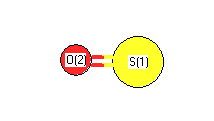Jump to
S2C1
Energy calculated at CCSD(T)/aug-cc-pCVTZ
| | hartrees |
|---|
| Energy at 0K | -472.830905 |
| Energy at 298.15K | |
| HF Energy | -472.409834 |
| Nuclear repulsion energy | 45.376171 |
The energy at 298.15K was derived from the energy at 0K
and an integrated heat capacity that used the calculated vibrational frequencies.
Geometric Data calculated at CCSD(T)/aug-cc-pCVTZ
Point Group is C∞v
Cartesians (Å)
| Atom |
x (Å) |
y (Å) |
z (Å) |
|---|
| S1 |
0.000 |
0.000 |
0.498 |
| O2 |
0.000 |
0.000 |
-0.995 |
Atom - Atom Distances (Å)
 More geometry information
More geometry information
Electronic energy levels
Charges, Dipole, Quadrupole and Polarizability
Jump to
S1C1
Energy calculated at CCSD(T)/aug-cc-pCVTZ
| | hartrees |
|---|
| Energy at 0K | -472.794398 |
| Energy at 298.15K | |
| HF Energy | -472.340770 |
| Nuclear repulsion energy | 45.002793 |
The energy at 298.15K was derived from the energy at 0K
and an integrated heat capacity that used the calculated vibrational frequencies.
Geometric Data calculated at CCSD(T)/aug-cc-pCVTZ
Point Group is C∞v
Cartesians (Å)
| Atom |
x (Å) |
y (Å) |
z (Å) |
|---|
| S1 |
0.000 |
0.000 |
0.502 |
| O2 |
0.000 |
0.000 |
-1.003 |
Atom - Atom Distances (Å)
 More geometry information
More geometry information
Electronic energy levels
Charges, Dipole, Quadrupole and Polarizability
